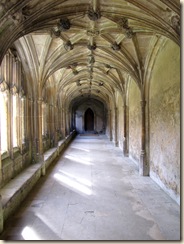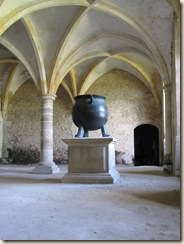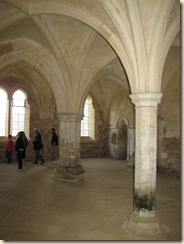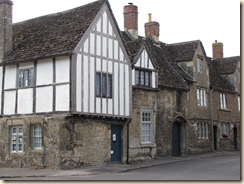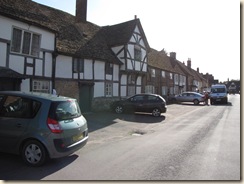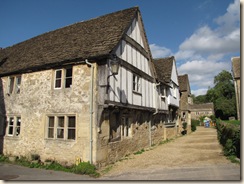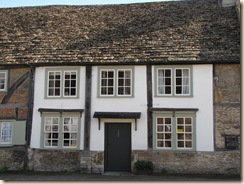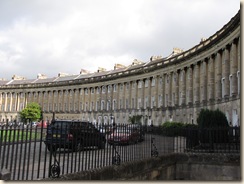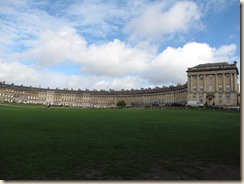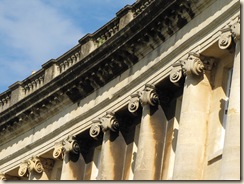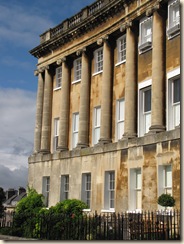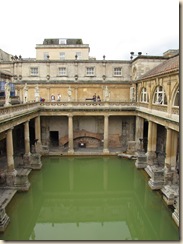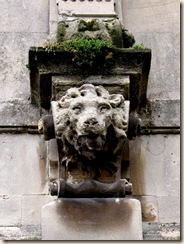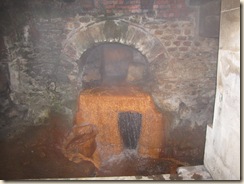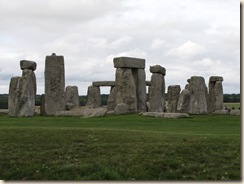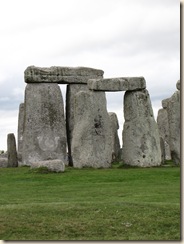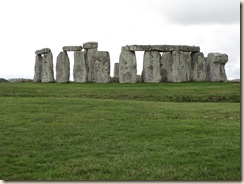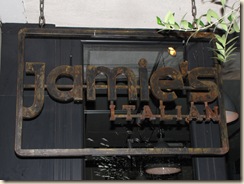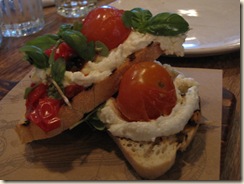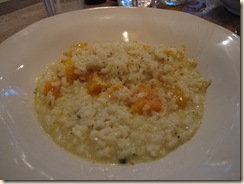Writing this blog isn’t as fun when its done at JFK while on a 5 hour layover, but at least it reminds me of happier times.
When Kevin and I discussed what to do on our last full day in Bath, I came up with the idea of going to the Jane Austen Center – a museum about Jane’s life during the time she lived in Bath. Surprisingly enough, Kevin wasn’t keen on this idea, and instead mentioned going to Bath Abbey. We debated what to do during breakfast and finally decided to head down to town and figure it out when we got there. However, the weather was really uncooperative towards a walk around town. It was sunny for literally 2 minutes and then would pour for 10 followed by a short period of sun and more downpours. Every time it started to pour, we tried to duck into a shop in the outdoor shopping center located on the outskirts of town center. Kevin wanted a new pair of Pumas, which are hard to come by in England and I just wanted an object. Neither of us wound up finding anything, but at least it kept us dry. Eventually, we wound up near the abbey, but I vetoed the idea since I wanted to be able to take pictures and I couldn’t do so in the rain. Instead, I cleverly re-directed us to the Jane Austen Center. I found out after the fact that Kevin was trying to stall me until after lunch so that he could go to the pub instead, but I didn’t really catch on to this. He was, nevertheless, a good sport.
Like almost all females, I love Jane Austen. I just can’t get enough of her romance stories set amongst the gentry in the time in which she lived. Jane Austen spent a great deal of time in Bath, having an aunt who lived there and living there herself for 4 years and thus Bath is featured heavily in her stories. Two of her books (coincidentally her first and last) were set in Bath and several other stories make mention of it. The museum, located in a Georgian house on Gay Street much like the house just up the road that Jane lived in, focuses on the history of Bath during the 4 years she lived there, and how Bath influenced her writing. For me, it was a fascinating look into Jane Austen’s life. Kevin, I’m sure, was extremely bored, but he at least pretended to look at everything and even waited for the 10 minutes it took me to decide what Mr. Darcy inspired treasures to purchase for myself and Katie from the gift shop. The only time he really started to loose his cool was when I couldn’t contain my love for the painting of Colin Firth as Mr. Darcy that they had hanging on the wall.
After I had my fill of Jane Austen history and the delicious Mr. Darcy, we decided to grab a bite to eat at the Tea Shop located on the top floor of the museum. I of course had the cream tea, which to me is the most delicious thing on the planet – even more so than goat cheese, pasta or chocolate. Their scones were warm right from the oven and the tea (a blend based on what people of the Georgian period would have drank) was perfect. As I was extolling the virtues of cream tea to Kevin, I came up with a brilliant plan – a party involving scones, tea and viewing of Pride and Prejudice (the BBC version of course). Kevin seemed to think this the most ridiculous idea I have ever come up with (shocking I know). He seemed to think that the only person who lived close enough to come that would show up would be my dear friend Katie (Mini Deal and Sharon living too far away to attend). He did laugh when I retorted with “ All you need for a good party is Katie anyway!”
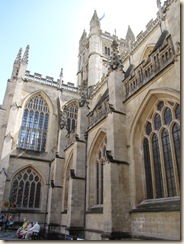 After tea, I released Kevin from his torture and we headed over to
After tea, I released Kevin from his torture and we headed over to  Bath Abbey. The last great Abbey built in England, it is not nearly as grand at Westminster or York, but I wouldn’t expect it to be as Bath wasn’t nearly on the same level of ecclesiastic power that York and Westminster were. However, it was still an impressive site. The abbey also offered a guided tour up the tower, which we decided to check out (by we I mean Kevin. I hate heights and steep narrow spiral staircases that are so predominate in abbeys and castles throughout England. However, since he was such a good sport about the Jane Austen museum, I decided to tough it out). The climb wasn’t nearly as bad as some other places I have been in throughout the past year, but it was still not my cup of tea. However, it was worth it for the explanation of all the different ways that the bells have been rung over the years. Plus,
Bath Abbey. The last great Abbey built in England, it is not nearly as grand at Westminster or York, but I wouldn’t expect it to be as Bath wasn’t nearly on the same level of ecclesiastic power that York and Westminster were. However, it was still an impressive site. The abbey also offered a guided tour up the tower, which we decided to check out (by we I mean Kevin. I hate heights and steep narrow spiral staircases that are so predominate in abbeys and castles throughout England. However, since he was such a good sport about the Jane Austen museum, I decided to tough it out). The climb wasn’t nearly as bad as some other places I have been in throughout the past year, but it was still not my cup of tea. However, it was worth it for the explanation of all the different ways that the bells have been rung over the years. Plus,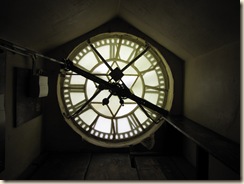 the look on Kevin’s face when the tour guide let him ring one of the big church bells was priceless. Not surprising, I refused to look off the top of the tower, but Kevin was nice enough to take pictures for me.
the look on Kevin’s face when the tour guide let him ring one of the big church bells was priceless. Not surprising, I refused to look off the top of the tower, but Kevin was nice enough to take pictures for me. 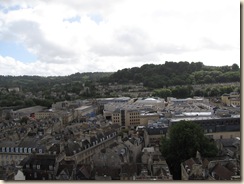
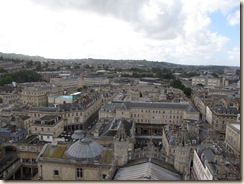
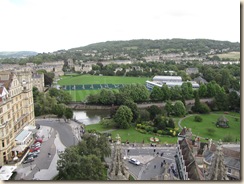
With the Abbey checked of our list of things to do, we were out of things in Bath that we had planned on accomplishing during our two days there. We decided to head to the town of Lacock (go ahead, laugh at the name. Kevin did.) which is located a mere 14 miles from Bath. Lacock is a village owned almost entirely by the National Trust since 1944 and is a great example of 18th century architecture. Because the town has remained mostly unchanged since the 1800s (there aren’t even any visible phone lines or street lights in town), it has become a favorite filming location. Most notably for myself, the village served as Meryton in my much loved BBC version of Pride and Prejudice and Lacock Abbey was used as Hogwarts in three Harry Potter movies.
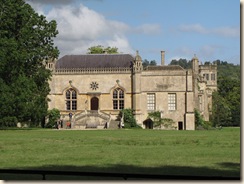 Since we were nearing closing time of the abbey, we headed there first to try and identify the areas used in Harry Potter. The abbey itself was first established in 1232 and retains much of the medieval parts of the abbey. Its easy to see why filmmakers chose it as the setting of Hogwarts. Right away, I found my first Harry Potter backdrop in the courtyard just inside the door. Appearing in numerous forms in the first two Harry Potter movies, the grassy courtyard is probably best known for the snowy scene, which I managed to find a picture of.
Since we were nearing closing time of the abbey, we headed there first to try and identify the areas used in Harry Potter. The abbey itself was first established in 1232 and retains much of the medieval parts of the abbey. Its easy to see why filmmakers chose it as the setting of Hogwarts. Right away, I found my first Harry Potter backdrop in the courtyard just inside the door. Appearing in numerous forms in the first two Harry Potter movies, the grassy courtyard is probably best known for the snowy scene, which I managed to find a picture of.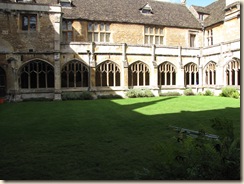

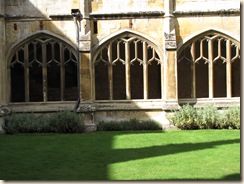

Up next, the hallways around the courtyard, used the hallway outside Dumbledore’s office.
A little more ornate in the film and crowded with students, but still recognizable to a super fan like myself.
Several of the rooms off the corridors were used as various classrooms in the first two Harry Potter films
Professor Quirrel’s classroom. Interestingly enough, the cauldron was already in the room.
Professor McGonnagall’s room
Professor Snape’s Potion Room
Filming returned to Lacock with the filming of Harry Potter and the Half Blood Prince. Lacock Abbey was used once again. However, the village of Lacock featured in this film as well, being the fictional village where Harry and Dumbledore find Horace Slughorn.
Not only has Harry and Dumbledore visited Lacock, but the Bennett sisters as well.
Lacock is a quaint little town, and even minus its association with two of my loves (Mr. Darcy and Harry Potter), its well worth a trip. It’s easy to picture the streets bustling with a giggling Lydia Bennett, a parade of soldiers or men on horses.



